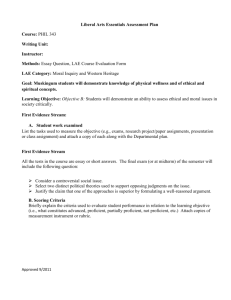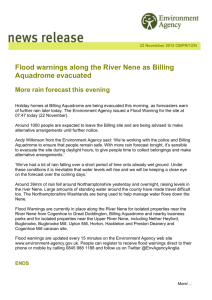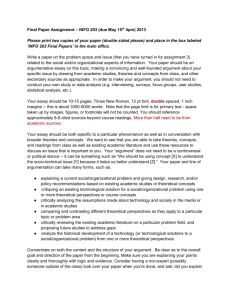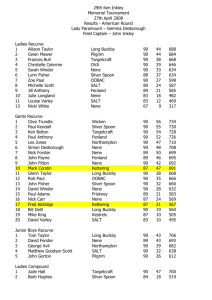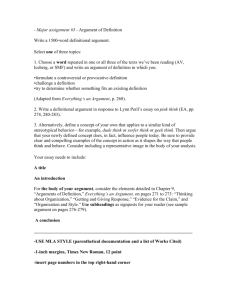PHIL3319-11
advertisement
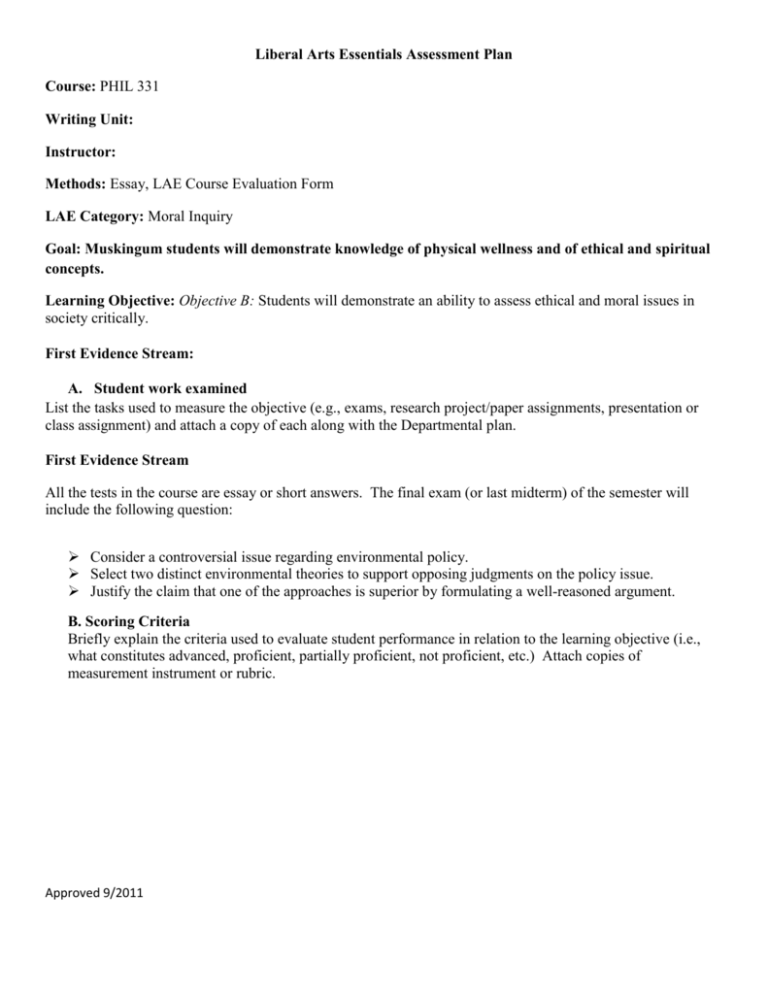
Liberal Arts Essentials Assessment Plan Course: PHIL 331 Writing Unit: Instructor: Methods: Essay, LAE Course Evaluation Form LAE Category: Moral Inquiry Goal: Muskingum students will demonstrate knowledge of physical wellness and of ethical and spiritual concepts. Learning Objective: Objective B: Students will demonstrate an ability to assess ethical and moral issues in society critically. First Evidence Stream: A. Student work examined List the tasks used to measure the objective (e.g., exams, research project/paper assignments, presentation or class assignment) and attach a copy of each along with the Departmental plan. First Evidence Stream All the tests in the course are essay or short answers. The final exam (or last midterm) of the semester will include the following question: Consider a controversial issue regarding environmental policy. Select two distinct environmental theories to support opposing judgments on the policy issue. Justify the claim that one of the approaches is superior by formulating a well-reasoned argument. B. Scoring Criteria Briefly explain the criteria used to evaluate student performance in relation to the learning objective (i.e., what constitutes advanced, proficient, partially proficient, not proficient, etc.) Attach copies of measurement instrument or rubric. Approved 9/2011 Examination Rubric Objective Student explains the arguments for two contrasting judgments on a policy issue, by using two distinct environmental theories to support the judgments. 4 Student explains the arguments for two contrasting judgments on a policy issue, by using two distinct environmental theories to support the judgments. 3 Student explains the arguments for two contrasting judgments on a policy issue, but with some omissions in the environmental theories used to support the judgments Student justifies the claim that one of the two theoretical approaches is superior. Student justifies the claim that one of the two theoretical approaches is superior by formulating a coherent argument with explicit reasons. Student justifies the claim that one of the two theoretical approaches is superior by formulating an argument with some omissions or flaws in reasoning. 2 Student’s explanation of the arguments involves significant omissions and errors regarding the ethical theories. For example, if one approach is explained, the other is omitted. Or, if both approaches are explained, there are significant content errors. Student justifies the claim that one of the two theoretical approaches is superior by formulating an argument with significant omissions or flaws. 1 Student does not explain the ethical theories. Student does not formulate an argument about which approach is superior. Score: +_______/8 Exceeds Expectations: 7-8 Meets Expectations: 5-6 Fails to Meet Expectations: 4 and below. Second Evidence Stream The LAE assessment tool will be used. Exceeding expectations will be defined as a student giving an average score across the four questions of 3.68 – 5.00. Meeting expectations will be defined as a student giving an average score across the four questions of 2.33 - 3.67. Failing to meet expectations will be defined as a student giving an average score across the four questions of 1 – 2.32. Approved 9/2011 Example of First Stream of Evidence: Philosophy 331 Final: Tuesday May 4, 8:30. This test is worth 100 points. Answer this question in your bluebooks. The nene (Hawaiian goose) is the state bird of Hawaii and is one of at least twenty-nine threatened and endangered species on Hawaii. Much of the original decline of the nene resulted from overhunting, the conversion of former goose habitat to agriculture, and introduction of the rat and mongoose to the islands. Despite a fifty-year recovery effort, the nene is still on the edge of extinction, and there are no known selfsustaining populations on the island. Is it worth continuing the effort to establish the nene? On the negative side is the observation that much of the original and prime nene habitat has been lost from the islands. Further, the nene seems to capitalize on nonnative exotic plants. The problem is that virtually all goose populations in North America are managed by providing food (grasses or agricultural crops) and the Hawaiian agencies do not want this—they want exotic/non-native plants removed and not increased. There are at least twelve other bird species even more endangered than the nene, and the islands’ biodiversity might benefit from the recovery efforts for these species too (which would require introducing non-native species). The supporters of the nene argue that some fifty years of effort in saving these birds would be wasted if support for the nene were withdrawn. If efforts are stopped now, other threatened birds might be impacted as well. Make an argument in favor of the goose preservation, at the expense of native plant life. Then make an argument against the goose preservation, in favor of the native plant life. For each argument use one of the following environmental ethics’ philosophies: Regan’s animal rights position, Leopold’s land ethic, Taylor’s biocentrism, Russow’s approach to species protection. (Obviously you can’t use the same one twice). After you have made the arguments for both sides, pick the one that you think does the best job in arriving at the best solution. The key to doing well on this essay is showing that you comprehend the theories that you are using. NOTE: The exam begins at 8:30. You should spend approximately 30 minutes on this exam. It is expected that you will write about four to five blue paragraphs maximum. Approved 9/2011
